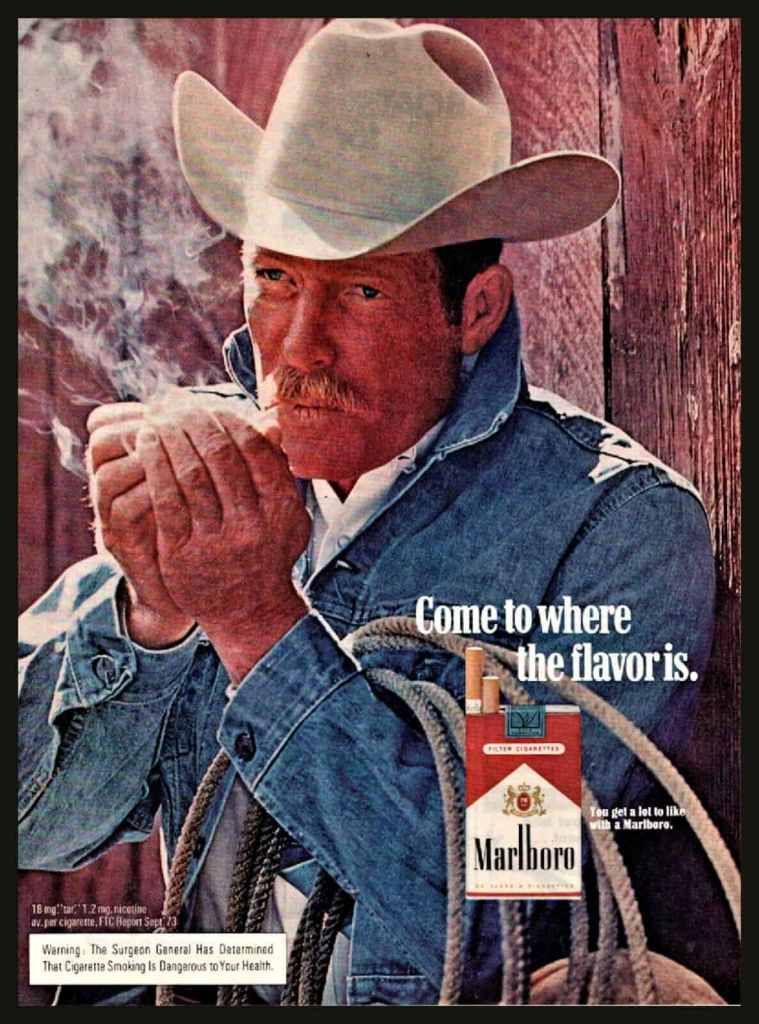In the crowded world of 20th-century advertising, few figures stood taller—or smoked more iconically—than the Marlboro Man. He wasn’t just a cowboy on a billboard but a symbol of rugged individualism, masculine idealism, and Americana itself. Long after his last commercial aired, the Marlboro Man remains one of history’s most recognized advertising icons. But how did a cigarrillo once marketed to women become synonymous with cowboy masculinity and global dominance?
This article explores the origin, evolution, and enduring legacy of the Marlboro Man, shedding light on how a fictional character changed the face of advertising forever.

1. The Birth of the Marlboro Man: From Feminine to Fearless
In the early 1950s, Marlboro was marketed as a filtered cigarette for women, with the tagline: “Mild as May.” But filtered cigarettes were stigmatized as “less masculine,” which limited their market share among men.
Philip Morris turned to advertising agency Leo Burnett, who proposed a radical rebranding. The solution? Reinvent Marlboro as a masculine brand by associating it with the ultimate American archetype: the cowboy.
Thus, the Marlboro Man was born—a strong, silent figure who rode horses, wrangled cattle, and lit cigarettes with a flint of stoicism. This image instantly shifted the perception of filtered cigarettes, making them acceptable—even aspirational—for men.
2. Emotional Branding at Its Finest
The brilliance of the Marlboro Man wasn’t just in the imagery. It was in the story.
Rather than focusing on the product, the campaign sold a lifestyle: freedom, independence, self-reliance. It was emotional branding decades before the term became mainstream. The Marlboro Man didn’t speak, push, or sell—he existed. His world was open, vast, and intensely masculine.
This type of storytelling bypassed logic and hit the heart. The cowboy became a canvas onto which consumers projected their dreams, desires, and identities.

3. A Global Campaign with Local Touches
Though the Marlboro Man was born in America, the campaign went global—quickly.
Across continents, the cowboy imagery was adapted for local sensibilities. In Australia, the man became a rancher. In Argentina, he was a gaucho. In Eastern Europe, he took on a rugged explorer aesthetic. But the underlying message remained no matter where the ads appeared: strength, solitude, and control.
Despite cultural nuances, the red-and-white box and the silhouette of the cowboy were instantly recognizable—a triumph of consistent global branding.
4. Cultural Penetration and Pop Icon Status
The Marlboro Man campaign didn’t just influence advertising—it reshaped popular culture.
He appeared on billboards, magazines, TV, and even inspired films and fashion. “Marlboro Country” became a metaphor for a rugged, untamed life. Leather jackets, cowboy boots, and dusty highways all fed into the Marlboro mythos.
In 1999, Advertising Age named the Marlboro Man the #1 campaign of the 20th century—beating out Apple’s “1984,” Coca-Cola’s “I’d Like to Buy the World a Coke,” and Nike’s “Just Do It.”
5. Backlash, Health Warnings, and Irony
However, the campaign wasn’t without consequences.
Many of the men who portrayed the Marlboro Man died of smoking-related illnesses, leading anti-smoking advocates to dub them “The Marlboro Men Who Died of Lung Cancer.” The image that once symbolized vitality became a dark irony.
Governments began regulating tobacco advertising, with outright bans on television, outdoor billboards, and even branded packaging. Still, the emotional residue of the Marlboro Man campaign lingered—and arguably still does.
6. The Lessons for Modern Advertisers
Even as the world moves away from tobacco marketing, the Hombre Marlboro campaign holds critical lessons for brand strategists:
- Build myth, not just messaging – Consumers connect with archetypes, not product specs.
- Consistency breeds recognition – The Marlboro Man campaign remained visually consistent for over 40 years.
- Less is more – No voice-overs, copy-heavy ads—just imagery and emotion.
- Globalize smartly – Core brand identity stayed intact, while local variations allowed deeper cultural resonance.
7. Legacy in a Smoke-Free Era
Today, Philip Morris International is investing billions into smoke-free products and rebranding itself as a “science-driven wellness company.” Yet, the ghost of the Marlboro Man still gallops in the background—appearing in art, fashion editorials, museum retrospectives, and branding textbooks.
Even as advertising becomes digital, fast, and algorithmic, marketers continue to study the Marlboro Man as a case study of how a single image, consistently and emotionally executed, can shape global perceptions for decades.
Final Thoughts: The Cowboy Rides On
The Marlboro Man is more than a memory—he’s a masterclass in identity creation. While smoking may fade and regulations may evolve, the cowboy’s image is a monument to what advertising can achieve at its best (and worst).
For marketers, creatives, and brand strategists, the Marlboro Man reminds us that icons aren’t born—they’re built.
Looking for more insights into iconic brand campaigns?
Subscribe to our blog for weekly deep dives into the world’s most legendary advertising strategies and branding case studies.
